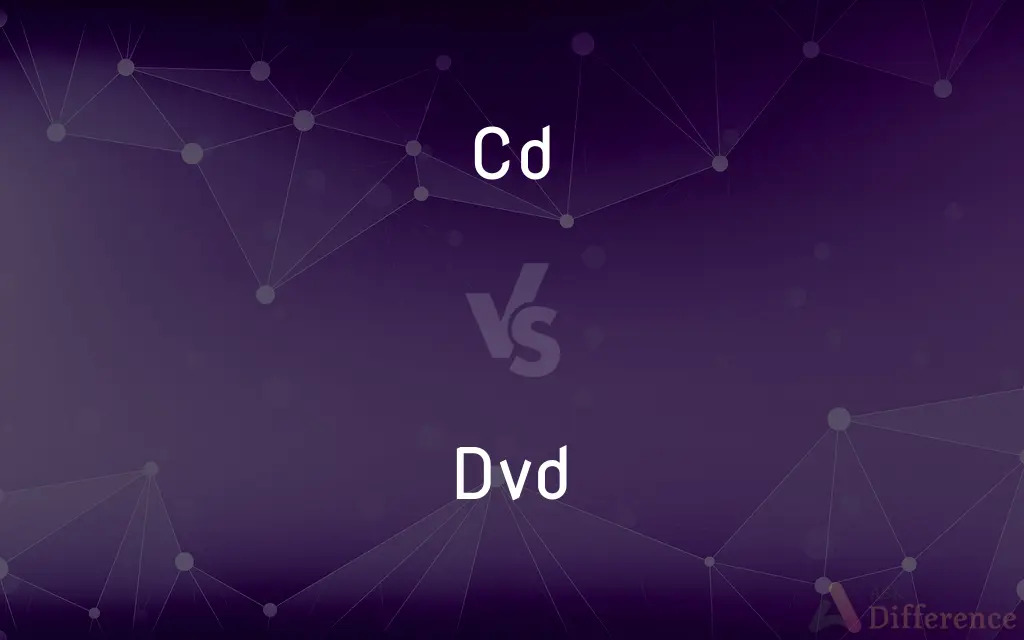CD vs. DVD — What's the Difference?
By Tayyaba Rehman — Updated on October 3, 2023
CD (Compact Disc) stores data/music, while DVD (Digital Versatile Disc) stores videos/data & has larger capacity.

Difference Between CD and DVD
Table of Contents
ADVERTISEMENT
Key Differences
CD, short for Compact Disc, was introduced in the early 1980s primarily for audio storage. DVDs, or Digital Versatile Discs, came later in the 1990s and revolutionized how we store and watch movies.
A significant difference between CD and DVD is their storage capacities. While a standard CD offers about 700MB of data storage, a standard DVD provides around 4.7GB, making DVDs more suitable for storing longer video content.
CD primarily uses a red laser for reading data, whereas DVD uses a shorter wavelength, typically a red or even blue-violet laser. This is partly why DVDs can store more data.
Both CD and DVD have had significant impacts on their respective industries, but with the rise of streaming and cloud storage, their relevance has declined.
Comparison Chart
Full Form
Compact Disc
Digital Versatile Disc
ADVERTISEMENT
Introduction Year
Early 1980s
1990s
Primary Use
Audio storage
Video and data storage
Storage Capacity
Approximately 700MB
Approximately 4.7GB
Laser Type
Red laser
Red or blue-violet laser
Compare with Definitions
Cd
Digital storage medium.
I saved my project on a CD.
Dvd
Digital storage with higher capacity than CD.
I burned the data onto a DVD because it was too large for a CD.
Cd
A circular disc used to store audio.
I listened to my favorite album on a CD.
Dvd
A disc used primarily for video storage.
We watched a movie on a DVD last night.
Cd
An optical disc technology.
The CD became less popular with the advent of streaming.
Dvd
Common format for home video.
The latest blockbuster is out on DVD.
Cd
Predominantly used for music.
The band released their new song on a CD.
Dvd
Can contain interactive content.
The DVD had a menu and bonus features.
Cd
A compact disc.
Dvd
An optical disc with versatile uses.
Apart from movies, the software was also available on DVD.
Cd
The chemical suymbol for cadmium, a metallic element of atomic number 48.
Dvd
A type of compact disc able to store large amounts of data, especially high-resolution audiovisual material.
Cd
The abbreviation for the candela, the basic unit of luminous intensity adopted under the System International d'Unites.
Dvd
A high-density optical disc for storing large amounts of data, especially high-resolution audio-visual material.
Cd
An acronym for compact disk, a disk-shaped recording of binary data that is smaller than a phonograph record, and is recorded and played back by a compact disk player, an electronic device containing a laser. The term is also used generically to refer to the medium as a data storage medium.
Dvd
A digital videodisc; a recording (as of a movie) on an optical disk that can be played on a computer or a television set
Cd
A compact disk player.
Cd
An acronym for certificate of deposit, a debt instrument issued by a bank for a fixed time period, usually paying interest.
Cd
A soft bluish-white ductile malleable toxic bivalent metallic element; occurs in association with zinc ores
Cd
The basic unit of luminous intensity adopted under the Systeme International d'Unites; equal to 1/60 of the luminous intensity per square centimeter of a black body radiating at the temperature of 2,046 degrees Kelvin
Cd
A debt instrument issued by a bank; usually pays interest
Cd
A digitally encoded recording on an optical disk that is smaller than a phonograph record; played back by a laser
Cd
Being one hundred more than three hundred
Cd
Physical format for software distribution.
I installed the software from a CD.
Common Curiosities
What laser type does a CD use?
CDs use a red laser for reading data.
How much data can a standard CD hold?
A standard CD can hold approximately 700MB of data.
When was the CD introduced?
The CD was introduced in the early 1980s.
What does CD stand for?
CD stands for Compact Disc.
What is the primary use of a CD?
CDs are primarily used for audio storage.
What differentiates a DVD from a CD in terms of storage?
A DVD generally has a larger storage capacity than a CD, around 4.7GB for a standard DVD.
What laser type does a DVD use?
DVDs use either a red or blue-violet laser.
When was the DVD introduced?
The DVD was introduced in the 1990s.
Are DVDs only used for movies?
No, DVDs can be used for data, software, games, and other forms of multimedia.
Why can DVDs hold more data than CDs?
DVDs use a shorter wavelength laser, allowing for smaller data pits and thus more storage.
How does a DVD's storage capacity compare to a Blu-ray disc?
Blu-ray discs have a higher storage capacity than DVDs, starting at 25GB.
What does DVD stand for?
DVD stands for Digital Versatile Disc.
Are CDs and DVDs still popular?
With the rise of streaming and digital downloads, the popularity of CDs and DVDs has declined.
Can both CDs and DVDs be re-written?
Yes, there are re-writable versions called CD-RWs and DVD-RWs.
Are there different sizes of CDs and DVDs?
The standard size for both CDs and DVDs is 120mm in diameter, but there are also smaller 80mm versions available.
Share Your Discovery

Previous Comparison
Kathak vs. Kathakali
Next Comparison
Cotext vs. ContextAuthor Spotlight
Written by
Tayyaba RehmanTayyaba Rehman is a distinguished writer, currently serving as a primary contributor to askdifference.com. As a researcher in semantics and etymology, Tayyaba's passion for the complexity of languages and their distinctions has found a perfect home on the platform. Tayyaba delves into the intricacies of language, distinguishing between commonly confused words and phrases, thereby providing clarity for readers worldwide.
















































